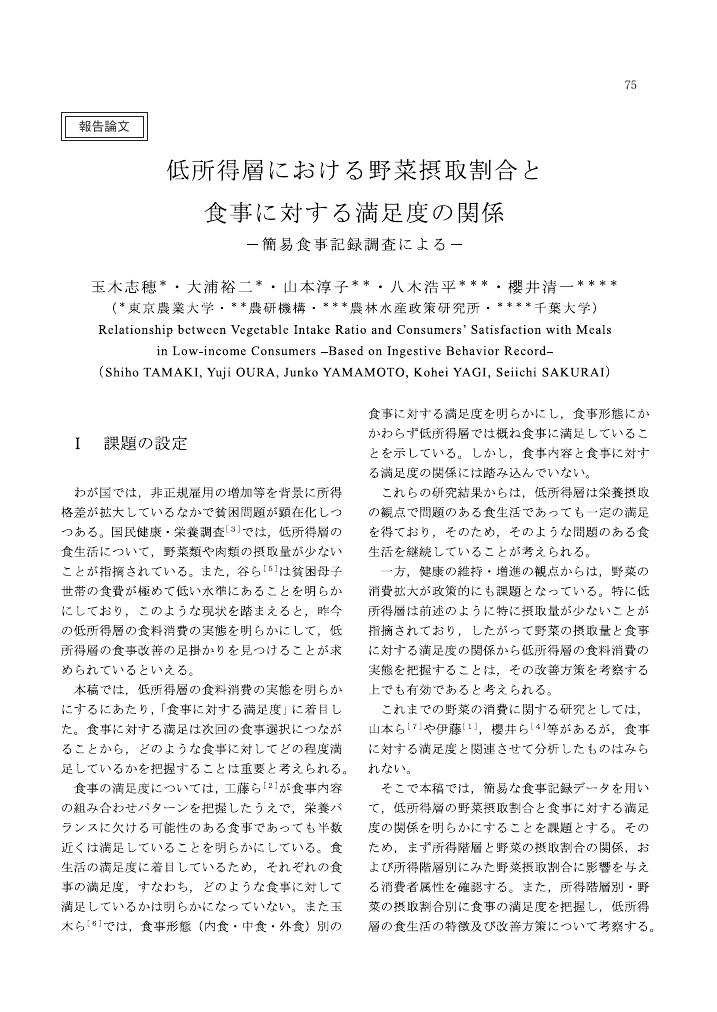95 0 0 0 OA 奄美農業の変貌 -作目の変化を通じて-
- 著者
- 萩原 茂
- 出版者
- 日本農業経営学会
- 雑誌
- 農業経営研究 (ISSN:03888541)
- 巻号頁・発行日
- vol.30, no.3, pp.35-45, 1992 (Released:2012-10-29)
7 0 0 0 OA 施設ギク生産の発展に与えた技術革新の性格とその効果 -愛知県渥美町を事例として-
5 0 0 0 OA ナッジで農作業安全対策を促すことはできるか? オンラインランダム化比較試験による効果検証
4 0 0 0 OA 内蒙古西部地域におけるカシミヤ生産と草原環境問題
4 0 0 0 OA イチゴにおける品種のネーミングと品種活用方策に関する研究
- 著者
- 半杭 真一
- 出版者
- 日本農業経営学会
- 雑誌
- 農業経営研究 (ISSN:03888541)
- 巻号頁・発行日
- vol.50, no.3, pp.1-16, 2012-12-25 (Released:2015-05-25)
- 参考文献数
- 13
- 被引用文献数
- 1
Many prefectures have created new strawberry varieties. However, the process of naming varieties has not been studied until now, and thus remains unclear. This study examines the strategies which a prefecture can take in naming strawberry varieties. It also presents the results of an analysis of variety names using consumer research, and thus aims to learn the naming method which best suits a prefecture’s strategy. The varieties analyzed for this study are: “TOCHIOTOME,” “SACHINOKA,” “SAGAHONOKA,” “BENIHOPPE,” “AMAOU,” “FUKUHARUKA,” “FUKUAYAKA,” and “MOUIKKO.” The results are as follows: First, the strategy which a prefecture takes is best explained by prefectural production practices and whether other prefectures are engaged in cultivation. There are two strategies which a prefecture that is characterized by a limited production scale and a limited market share can take. One is a strategy in which it captures a larger market share by allowing another prefecture cultivation rights to the variety, and a second aims at branding its product as local without permitting another prefecture to cultivate the variety. When permitting cultivation in another prefecture, it is effective that the name of the creating place is not included in a variety name. When aiming at branding a product as local, it also is effective that the name of the creating place not be included in the variety name. On the other hand, for prefectures with a big production scale, it is effective to include the name of the creating place. Second, the effectiveness of variety names was examined using consumer research. The consumer research was conducted in Fukushima Prefecture. The features of a variety name with consumers’ high evaluation are “it seems to be delicious,” “it being easy to memorize,” “it is lovely and pretty,” and “it is humorous and entertaining.” When it is hard to memorize similar variety names, evaluation is low. Moreover, suggestive images and nuance are the elements which influence evaluation of a variety name. An evaluation of sound symbolism performed beforehand was also checked using the results of the consumer research, and showed the importance of nuance. Although the name of a creating place is transmitted to consumers through suggestive images, the effect which improves comprehensive evaluation is small. When information is transmitted to consumers in a humorous and entertaining manner, the comprehensive evaluation of a variety name is comparatively poor. The implication of this study is that variety naming conforms to the strategy of the prefecture which creates the variety.
3 0 0 0 OA 生産調整の増収効果 -北海道稲作の立地移動に関する実証的研究-
- 著者
- 生源寺 真一
- 出版者
- 日本農業経営学会
- 雑誌
- 農業経営研究 (ISSN:03888541)
- 巻号頁・発行日
- vol.21, no.3, pp.48-59, 1984 (Released:2012-10-29)
- 参考文献数
- 5
3 0 0 0 OA 韓国産パプリカ日本輸出急増要因の解明 韓国N貿易と日本D商社の連携を中心として
3 0 0 0 OA 共乾施設の荷受方式と稼働実態
- 著者
- 平泉 光一
- 出版者
- 日本農業経営学会
- 雑誌
- 農業経営研究 (ISSN:03888541)
- 巻号頁・発行日
- vol.30, no.1, pp.27-38, 1992 (Released:2012-10-29)
- 参考文献数
- 8
2 0 0 0 OA オランダケアファームの機能とその充足要件 日本の農福連携の発展に資するために
- 著者
- 植田 剛司
- 出版者
- 日本農業経営学会
- 雑誌
- 農業経営研究 (ISSN:03888541)
- 巻号頁・発行日
- vol.58, no.4, pp.15-20, 2021-01-25 (Released:2022-02-01)
- 参考文献数
- 10
2 0 0 0 OA 低所得層における野菜摂取割合と食事に対する満足度の関係 簡易食事記録調査による
2 0 0 0 OA 上場企業による農業参入の分析 人材育成と関連コストの問題を課題に
2 0 0 0 OA 有機野菜等の販売実態と業態別販売対応の方向性
2 0 0 0 OA 内モンゴル牧戸の収益性構造と経営的特質
1 0 0 0 OA TPP参加による鶏肉関税撤廃の影響分析と対応策
- 著者
- 信岡 誠治
- 出版者
- 日本農業経営学会
- 雑誌
- 農業経営研究 (ISSN:03888541)
- 巻号頁・発行日
- vol.52, no.1-2, pp.89-94, 2014-07-25 (Released:2017-01-16)
1 0 0 0 OA 米市場変革期における産地マーケティング戦略の課題
1 0 0 0 OA シカ捕獲個体利活用施設の経営収支 2タイプの比較
- 著者
- 伊庭 治彦
- 出版者
- 日本農業経営学会
- 雑誌
- 農業経営研究 (ISSN:03888541)
- 巻号頁・発行日
- vol.48, no.1, pp.1-11, 2010-06-25 (Released:2015-03-20)
- 参考文献数
- 16
- 被引用文献数
- 4
This study aims to clarify the support system for small family farms (SFFs) in the U.S. So far, SFFs have gotten scarcely any direct support from the public sector, while large-scale farms that grow targeted program crops have received large subsidies. Nowadays, SFFs are expected to build a new local food system by providing safe food. So, maintaining SFFs is perceived as one way for assisting U.S. agriculture.I start this paper by describing the American social welfare service system, because it is part of the basic structure of the SFF support system. Then, I characterize U.S. society as a mixed welfare society, which means that both the public and private sectors provide services to citizens. Next, three cases are analyzed from a viewpoint of actual activities that provide support to SFFs. At the end, a theory of the support system for SFFs is presented that flows from the case study results.The conclusions are as follows. First, non-profit support organizations help make the competitive grant programs efficient by means of employing professional staffs who can get competitive grants that are used to support the programs. Second, SFFs are linked to each other in a network to reduce the risk of failing to obtain competitive grants. The network works as a “safety-net.” Third, advocacy organizations have an important role in prompting the public sector to make effective and appropriate policy and grant programs for SFFs. Finally, I conclude that the combination of non-profit organizations and competitive grants make the support for SFFs efficient and effective under small budgets and in a mixed welfare society such as the U.S.














